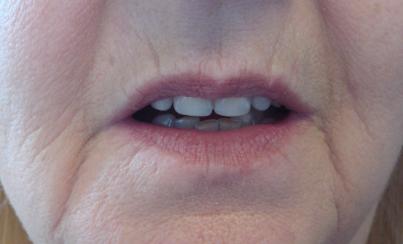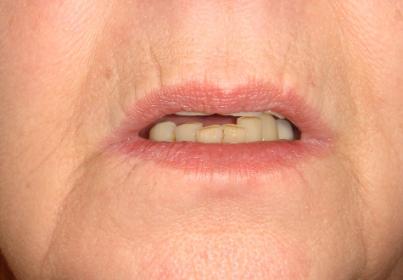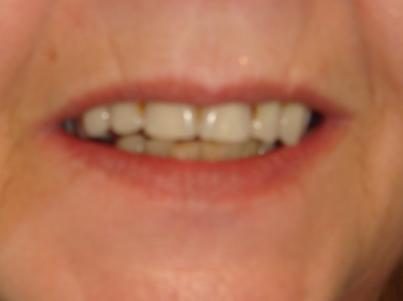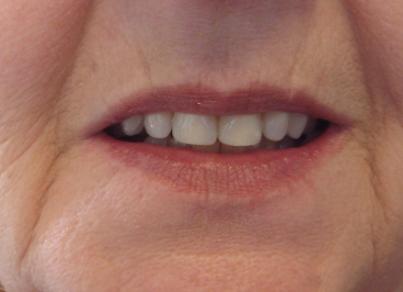Lip line and central incisor relationship
This client recently attended requesting a new upper and partial lower denture. She was not happy with her appearance and required a vast improvement in her appearance which required the remake of the lower denture. The following explanation is detailed to enable the lay person to understand the reasoning and principles that determine a natural smile. I endeavour to explain the two relationships of the lips to the teeth positioning in both smiling and at rest.
This case recently finished, describes how the central incisor level and a horizontal line taken from the corners of the mouth provide us with the correct tooth upper and lower lip relationship. Allowing for the corners of the mouth to drop slightly with age allows me to position with confidence the two central incisors. This client had a natural short upper lip and showed approx, half of her natural tooth,
Fig 1 Illustrates a true relationship between the upper and lower lip in relationship with the amount of upper and lower tooth showing.
Her previous denture at rest illustrated in fig 2 provides us with an example of misproprtion in cosmetic presentation. The client agreed that she never looked like this with her natural teeth. Again this demonstrates the 50/50 rule of proportion. The upper central incisors are not in the equaton.
In Fig 2, if an imaginary line were to be drawn from the corners of the mouth the central incisors are approx 3mm short of the proportionality.
This client confirmed that when she was younger,she did show her incisors and that they were evident at rest. The height of the bowed lip in relation to the horizontal lip plane is a tell tale sign of this lost relationship.
Clients long lost account of their appearance in their memory can in many cases be sparked into recognising an appearance they once experienced. In that their long lost lip/tooth relationship can be reinatalled. In reference to fig 2 appearance the client felt that she appeared miserable under the nose and around the mouth and had to work hard with her lips to show a comfortable smile.
In fig 3 the client had to really pull up her upper lip in order to show her upper teeth and thens he didnt like the appearance.
I always feel in cosmetic setting that the upper incisal edge should be parallel with the lower lip when smiling. This however is not always the case.
It is clearly evident in fig 3 that the upper incisal edges on the clients left and right hand side are not parallel to the lower lip. The upper left canine is prominent and lower down contacting the lower lip, in relationship to the right canine.
The lateral incisors do not match in height. the left lateral is 1mm too low whilst the right lateral is proportionally correct.
In fig 3 The client has to really force the upper lip up in order to show the centrals. Unfortunately when she does this the muscle action also reveals excessive exposure of the canine length. My feeling is that when excessive canine is visible then it can be a sign of agression imparting a dracula appearance.
The upper lip is lifted upwards using the muscles of expression which involes the angle or corner of the mouth. Since these muscles are adjacent to the canines if the canines are set too low down, then any elevation in this vicinity will undoubtedly result in higher than normal canine exposure. Prominent canines can also be evidence if masucline agressive appearance.
I was unable to highlight the nose width due to patient confidentiality and data protection, however I can confidentaility report that her previous dentures canine width in relation to her nose width appeared outside the accepted parameters.
Tooth selection was taken from her face width across the temples and the length which corresponded to a tappering mould with a narrow canine to add a degree of femininity. Her previous denture mould as you can probably observe was squarish with large laterals and canines imparting a masculine element. Considering she has a slender tappering face the previous denture was made with no planning.
In reflection of this case I was very pleased with the appearance and the client was likewise, fulfilling all her expectations.
The initial planning consultation of such cases is highly important with careful listening and recording accurately any comments the clients impart into the interaction. Attending relatives and friends are also an important asset together with photographs.
I was really pleased throughout the manufacturing process as communication with the client was excellent. I felt I was able to tune into her thoughts and what she felt was problematic about her present appearance with the previous dentures.
Must apologise for blurred photography in fig 3.
Fig 1 Client at rest wearing replacement denture.

Fig 2 Client at rest wearing presenting denture.

Fig 3 Client smiling with presenting denture.

Fig 4 Client smiling with replacement denture
